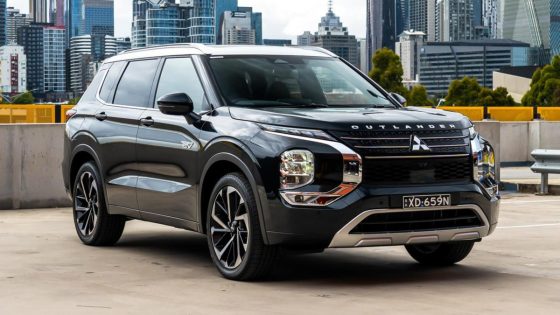You’re looking at Australia’s favourite plug-in hybrid (PHEV).
The Mitsubishi Outlander Plug-in Hybrid EV was one of the first PHEVs on the market, and the brand’s persistence in improving the technology has seen it retain top spot.
Now in its second generation, the Outlander PHEV is unique in offering a seven-seat option. The increase in battery size for this current generation means it has quite a high EV range claim (up to 84km NEDC) as well.
Given the absence of seven-seat rivals, the Outlander stands on its own. The BYD Sealion 6 is a five-seater, and plug-in versions of the Hyundai Tucson, Kia Sportage, and Volkswagen Tiguan aren’t offered locally.
The closest competition – especially for the flagship Outlander Exceed Tourer guise – is the even more expensive Kia Sorento PHEV.
Does this give Mitsubishi an automatic win if you’re shopping for a PHEV?
The short answer is yes… but it pays to consider which variant of Outlander Plug-in Hybrid EV is best for you, because there’s plenty of goodness in the cheaper grades.
At $71,790 plus on-road costs, this 2024 Mitsubishi Outlander Plug-in Hybrid EV Exceed Tourer is up to $15,000 more expensive than well-equipped conventional hybrids from other brands, but it still has some aces up its sleeve.
How much does the Mitsubishi Outlander cost?
The Exceed Tourer isn’t the top dog in the Outlander range anymore, but at $71,790 it slots in below the black pack-themed GSR ($73,790).

To see how the Mitsubishi Outlander lines up against the competition, check out our comparison tool.
What is the Mitsubishi Outlander like on the inside?
The Exceed Tourer dresses up the Outlander’s cabin a fair bit, which you’d hope so given the price.

There’s fetching black and orange leather trim with quilted contrast stitching and some nice detailing throughout, which definitely lifts the ambience compared to lower grades.
I know the brighter accents may not appeal to those with more conservative tastes, but I enjoyed the uniqueness and visual pop of the orangey bits.
The smooth leather and padded surfaces on the dashboard and doors (with contrast stitching accents) all look and feel well made, though parts of the door tops are still finished in hard, scratchy plastic.
At least the high-traffic touch points are nicely finished, including the chunky leather steering wheel, squidgy centre armrest, and padded elbow rests in the doors.




Front occupants are treated to heated seats with electric adjustment, as well as memory and massaging functions. They’re supple and supportive, and almost feel couch-like.
In the Exceed you also get a heated steering wheel which works well on chilly Melbourne mornings, and the Exceed Tourer tested here adds heated outboard rear seats too. It’s very nicely appointed.
The 12.3-inch digital instrument cluster and 9.0-inch touchscreen infotainment system are slowly rolling out across the Renault-Nissan-Mitsubishi Alliance, and they’re all pretty nice to look at and easy to use.
Here, there’s wireless Apple CarPlay (Android Auto is wired), as well as embedded satellite navigation and DAB radio. In higher grades the infotainment system is hooked up to a nine-speaker Bose-branded audio system which is pretty punchy, but not a standout compared to other premium systems at this price point.
The 12.3-inch cluster has some PHEV content like energy flow charts, and it’s pretty configurable – but not quite as customisable or pretty as Volkswagen Group units. It does dress the cabin up a bit.

Considering its family focus, the Outlander is pretty well catered for in terms of storage solutions.
There’s a wireless charging pad under the centre stack which is big enough for a large phone, bolstered by USB-A and USB-C ports and a 12V power outlet – these sit below a physical climate control panel.
Big bottles will fit in the deep door bins, and the cubby under the front-centre armrest has plenty of room for hiding other items away.
There are also two cupholders between the front seats, but there’s a blank space around the chunky shift-by-wire selector. I’m not the biggest fan of all the piano black trim, as it scratches easily and is prone to fingerprints.




The second row is where the Outlander’s increased size over rivals comes into play, boasting one of the more spacious rear seats in the segment – though competition is heating up.
With slide and recline adjustability, the second row can be configured to maximise boot- or third-row space, or slid back to maximise legroom with five passengers on board. Even with the panoramic sunroof in the Exceed Tourer, I can comfortably sit behind my own driving position – and I’m just over 6’1 tall.
The rear bench is supple and supportive, and the tall windows and panoramic roof really lighten the rear of the cabin. Directional air vents, a third zone of climate control, and heated outboard seats mean there are plenty of higher-end amenities back here too.
Rear seat practicality is bolstered by bottle holders in the doors, a fold-down centre seat with cupholders in the backrest, map pockets behind the front seats, as well as the requisite ISOFIX and top tether points for child seats.


The Outlander is one of few vehicles in its segment to offer a third row. Despite the fact it’s one of the longest vehicles in the medium SUV class, there’s a reason Mitsubishi says it’s a 5+2 setup instead of a full-on seven-seater.
The rearmost seats with their odd headrests are best left for smaller kids. I struggled to get in there to begin with, and there’s a real lack of headroom for tall teenagers or adults.
Knee-, leg- and toe room are also limited for those on the taller side; this is definitely suited to your younger kids and perhaps any of their friends that might tag along in your Outlander.
Still, props to Mitsubishi for offering one of the few three-row hybrid SUVs on the market.


The boot measures 494 litres (VDA) with all five seats in place, which is actually 9L up on the petrol version. Fold the seats down and there’s 1414L (VDA) to the roof.
Where petrol-powered Outlanders get either a full-size spare or space-saver depending on variant, the PHEV versions make do with a tyre repair kit.
To see how the Mitsubishi Outlander lines up against the competition, check out our comparison tool.
What’s under the bonnet?
The Outlander PHEV teams a 2.4-litre petrol engine with two electric motors and a lithium-ion battery.

My observed fuel consumption reading was of 361.8km of mixed driving of the course of the week, with the vehicle charged each night to 100 per cent via a conventional three-pin wall socket.
There was a good mix of city, suburban and freeway driving, with the average speed over that 361 kilometres shown as 42km/h.
It’s worth noting the Outlander Plug-in Hybrid EV is still one of few PHEVs on sale to offer DC fast charging. While Mitsubishi doesn’t quote a charge capacity figure, you can get the battery from 0-80 per cent in as little as 38 minutes using the CHAdeMO port, which also supports vehicle to grid (V2G) functionality.
To see how the Mitsubishi Outlander lines up against the competition, check out our comparison tool.
How does the Mitsubishi Outlander drive?
The Outlander Plug-in Hybrid EV remains one of the more impressive PHEVs to drive.

With dual-motor electric drive on tap, the Outlander PHEV is torquey and responsive in normal driving, despite the plug-in model’s significant 2.1-tonne heft.
You’ll be able to spend most of your time in EV mode if you fully charge it nightly, with 70-80km of range achievable according to our testing. For many, that’s two days worth of commuting.
Unlike some single-motor PHEVs that can feel sluggish and underdone in EV mode, the Outlander is sprightly and eager to respond to throttle inputs, making it a brisk operator in commuter traffic.
It effortlessly gets moving and will handle both urban and freeway speeds using just the battery. On the move, it’s a pretty quiet and refined place to be.

It appears the Outlander PHEV has additional sound deadening over the petrol version, as when the petrol engine does eventually fire to drive the wheels or feed energy to the battery, you can barely hear it even at high revs.
You only get a faint whir from the electric motors under acceleration, and at carpark speeds the sound to let pedestrians know you’re there is all you really hear. Road and wind noise are pretty well suppressed for the class, even on the Exceed Tourer’s big 20-inch alloy wheels.
That said, the bigger wheels can get busy over tram tracks and potholes in the city, but the added weight of the PHEV seems to have settled the Outlander’s body relative to the petrol versions.
As with other Outlander models the controls are light and heavily assisted, clearly focused on comfort and refinement as opposed to driver engagement. That’s no bad thing.

The light steering makes the 4710mm long and 1862mm wide Mitsubishi much easier to park – when the reversing camera is working – and less of a chore to thread through tight city streets and carparks.
Conversely, it can make the tall, wide front end feel vague at times, and the soft suspension means it’ll lean a bit through sharper turns. It feels more SUV-like than car-like in this regard.
Once the petrol engine kicks in when you’ve depleted the battery or stuck the Outlander in Hybrid or Power mode, it’ll primarily act as a series hybrid prioritising electric drive with the back-up of the petrol motor as a generator, though it’ll have all systems work together under hard acceleration.
At a cruise the electrified drivetrain shuffles between power sources to prioritise performance or efficiency. It’s quite a clever system – and we bettered the manufacturer’s claim over a week’s worth of driving with nightly charges.

The Exceed and up receive a full semi-autonomous driving suite, which combines the standard adaptive cruise control with lane centring to take the load off extended highway stints, and adds touch-capacitive sensors to the steering wheel rim so the car knows your hands are on the wheel even if you’re not making inputs.
Not only does this help on the open road, it’s quite helpful in traffic jams, allowing the Outlander to control acceleration, braking and steering when you reach a bottleneck at the end of a freeway, for example – as so many Melbournians like myself who travel on the M3 Eastern Freeway everyday would know.
The Outlander is otherwise well catered for with blind-spot monitoring and rear cross-traffic alert, as well as front and rear parking sensors to supplement the surround cameras standard from the Aspire grade and up. Camera quality is average, but the bird’s eye view makes it easy to place the Outlander in tight parking spaces and the like.
The last thing I’ll note is the PHEV’s ‘Innovative Pedal Operation Mode’, which offers one-pedal driving for most driving situations but will taper off as you reach crawling speeds and require you to use the brakes. I’m not a big fan of one-pedal modes because it can take some getting used to, and it’s annoying when coming off cruise control for the vehicle to suddenly hit the regenerative anchors, for example.
What do you get?
There are now five grades of Outlander PHEV on sale in Australia – here we have the penultimate Exceed Tourer.




Outlander Plug-in Hybrid EV ES highlights:
- Super All-Wheel Control (S-AWC)
- Variable Mode Regenerative Braking System
- Innovative Pedal Operation Mode
- 7 Drive Modes
- EV Charging and HVAC Scheduler
- Mode 4 DC port – V2G compatible
- Mode 3 charging cable
- Mode 2 AC charging cable
- Push-button start
- Paddle shifters
- Electric park brake
- 18-inch silver alloy wheels
- LED headlights with manual levelling
- LED daytime running lights
- LED front turn signal
- Rear spoiler LED high stop lamp
- Dual-zone climate control
- 9.0-inch touchscreen
- Satellite navigation
- 12.3-inch digital driver display
- 6 x speakers including 2 x tweeters
- Wireless Apple CarPlay
- Wired Android Auto
- Bluetooth phone and audio streaming
- DAB+ radio
- Cloth seat trim
- Acoustic Vehicle Alert System
- Rear Seat Alert
- 40:20:40 split 2nd row incl. recline adjustment
- Tyre repair kit (Replaces Full Size Spare)
- Rear LED fog lights
Outlander Plug-in Hybrid EV Aspire adds:
- 20-inch two-tone alloy wheels
- Smart key
- Head-up display
- Wireless smartphone charger
- 240V/1500W power outlets
- Privacy glass
- Electrochromatic rear-view mirror
- Roof rails
- LED headlights with auto levelling
- LED front fog lights
- Leather steering wheel
- Leather gearshift knob
- Microsuede, leatherette seat trim
- Heated front seats
- Power driver seat incl. lumbar
- Power tailgate incl. one-touch open
- Multi Around Monitor (MAM)
- Adaptive high beam
- Rain sensing wipers


Outlander Plug-in Hybrid EV Exceed adds:
- 5+2 seats
- BOSE 9-speaker premium audio
- Panoramic sunroof
- Pull-up rear roll sunshade
- Power tailgate – hands free
- Tri-zone climate control
- Black leather-appointed seat trim
- Light Grey leather-appointed seat trim – optional
- Front seats with memory function
- Power passenger seat
- Third row recline adjustment
- Unique illumination in front door trim
- Aluminium gearshift trim panel
- Heated steering wheel
- Front LED sequential indicators
- MI-Pilot
Outlander Plug-in Hybrid EV Exceed Tourer adds:
- Two-tone exterior body colour
- Two-Tone high-grade leather-appointed seat trim
- Front seats with massage function
- Heated rear seats
Outlander Plug-in Hybrid EV GSR adds:
- 20-inch black alloy wheels
- Gloss black front & rear under garnish
- Gloss black grille
- Gloss back door mirrors
- Gloss black roof rail
- Black ‘Outlander’ bonnet emblem
- Black leather appointed seat trim
- Silver stitching
Is the Mitsubishi Outlander safe?
The Outlander wears a five-star ANCAP safety rating based on 2022 tests – applying to all variants including PHEV models.

It received an adult occupant protection rating of 83 per cent, a child occupant protection rating of 92 per cent, a vulnerable road user protection rating of 81 per cent, and a safety assist rating of 83 per cent.
Standard safety features include:
- 8 airbags incl. front-centre, driver’s knee
- Adaptive cruise control
- Auto high-beam
- Autonomous Emergency Braking (AEB)
- Blind-spot monitoring
- Driver attention alert
- Forward collision warning
- Lane departure warning
- Lane keep assist
- Parking sensors front, rear
- Rear cross-traffic alert
- Reversing camera
- Traffic sign recognition
Outlander Exceed adds:
- MI-Pilot
- Speed Limit Assist
How much does the Mitsubishi Outlander cost to run?
If you service with Mitsubishi, you get the longest new car warranties in the business.

To see how the Mitsubishi Outlander lines up against the competition, check out our comparison tool.
CarExpert’s Take on the Mitsubishi Outlander
In many ways, the Outlander Plug-in Hybrid EV stands alone in the Australian market.

Few other carmakers are able to offer such a range of PHEV models, and the Outlander’s mix of practicality and long EV driving range puts it ahead of the competition.
The Exceed Tourer probably isn’t the sweet spot in the range, due to its high purchase price and lack of show-stopping additions over the $2500 cheaper Exceed.
If you’re buying privately the $15,000+ premium over the petrol Exceed Tourer might be a hard pill to swallow, but for fleet operators and novated leases, the FBT exemptions will no doubt close that gap.
I believe the five-seat Aspire is the best value at nearly $20,000 cheaper than the car you see here but still covers most bases in terms of features and tech, but if you want the segment-unique option of three rows the Exceed is the best value.
Regardless, the Outlander PHEV is a well-rounded option for Australian families looking to dip into plug-in electrification without going full EV, with a seating format and balance of capabilities that few rivals can match.

MORE: Buy a Mitsubishi OutlanderMORE: Everything Mitsubishi Outlander
Pros
- Benchmark EV range, DC charging
- Rare-for-segment three-row seating
- Up to 10 years warranty
Cons
- $77,000 drive-away for an Outlander!
- Some bits can’t hide affordable roots
- Third-row seats are best for little kids
Top Line Specs
- Power: 98kW
- Fuel Type: Premium Unleaded/Electric
- Economy: 1.5L/100km
- CO2 Emissions: 35g/km
- ANCAP Safety Rating: 5
Source Agencies




